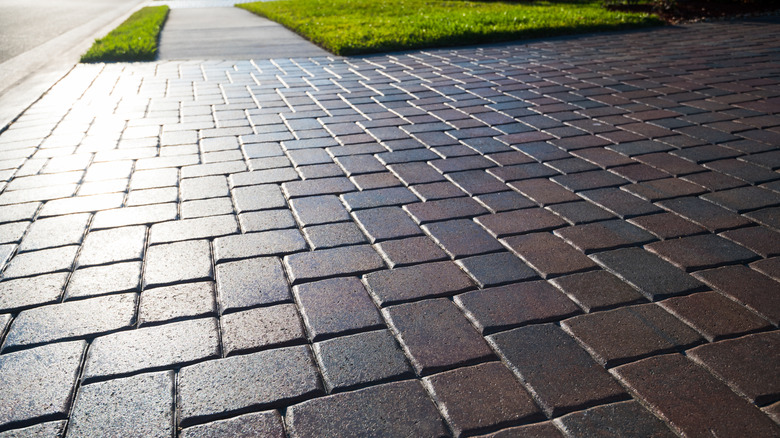Here's Why You Shouldn't Skip Out On Paver Sealants
Pavers are a great alternative to grass for covering outdoor surface areas, thanks to their lower maintenance costs, greater durability, and numerous design possibilities. Available in brick, concrete, natural stone, and fieldstone (the most common type of paver material), pavers are relatively cheap and easy to install. Once positioned, pavers require straightforward upkeep, including cleaning, weed control, and replacement of any cracked or chipped pieces. Due to their composition, pavers can last for a substantial amount of time, averaging from a couple of decades to a century. To help ensure their longevity, using a sealant during installation and for maintenance shouldn't be skipped, if at all possible.
Paver sealants are specially formulated liquid compounds that act as a coating on pavers. By acting as a shield against environmental and man-made wear and tear, not using a sealant makes the pavers vulnerable to unwanted weed and algae growth. Also, the paver's surface and insides become susceptible to water and ice damage due to freezing and thawing cycles. Additionally, without the sealant's preservative properties, the pavers are prone to blemishes and stains and are more sensitive to discoloration. Together with understanding the importance of sealants, you should also know that there are some cons to consider before sealing your pavers.
There are two main categories of sealants: The first is the film-forming sealant, which produces a thin layer on the surface of the paver, making it water and stain-resistant. The second is the penetrating sealant, which saturates the porous surface and interior of the paver and, once inside, undergoes a reaction that makes the porous surface hydrophobic. It's important to note that, regardless of the type used, knowing the correct way to apply paver sealant is vital.
Sealant is an important finishing treatment for the patio
The primary benefit of using paver sealant is the protection it provides, starting with reducing the risk of fading from constant exposure to UV rays. Additionally, the sealant acts as a barrier that prevents staining from organic material like leaves and grass, as well as rust, oil, and grease. A sealant also adds to the aesthetic appeal of the pavers by highlighting the color and preserving their appearance. In terms of insect and weed protection, the protective coating for the pavers prevents insects, like ants, from establishing colonies in and between them, while also hindering weed germination and growth.
Alongside conventional sealants, other compounds can be used for pavers. The first is polymeric sand, which is composed of sand and polymers that are activated by water and harden into a tough and durable filler for the gaps between the pavers. Concrete dust that is produced during concrete mixing can also be used as a sealant, but care must be taken, as it can form lumps if not properly blended. Lastly, porcelain pavers are a great alternative to common paver materials due to their durability and non-porosity, giving them water and stain resistance, Essentially, these require no sealant treatment to maintain their appearance or keep them protected.
With the diverse selection of paver sealants, the key considerations for choosing which is best should include area usage, pedestrian traffic, weather exposure, the material of the pavers, and the expected look or finish. Finally, it's essential to take into account the maintenance requirements, which include how many touch-ups or re-applications the sealant will need during its lifetime.

